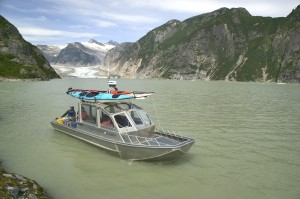 Naturalist John Muir first explored Alaska during a trip to the Island of Wrangell on July 14, 1879. Muir wasn’t impressed, saying “the most inhospitable place at first sight I had ever seen…There was nothing like a tavern or lodging-house in the village, nor could I find any place in the stumpy, rocky, boggy ground about it that looked dry enough to camp on until I could find a way into the wilderness to begin my studies.” Fortunately Muir fell into a group of Presbyterian missionaries that would leave their own historic mark on the state. One was the well-known Reverend Sheldon Jackson who started the Wrangell mission and was seen as a national spokesman on Alaskan affairs. Working with Benjamin Harrison, he obtained funds to begin a school system in the state and later established a self-named college in Sitka.
Naturalist John Muir first explored Alaska during a trip to the Island of Wrangell on July 14, 1879. Muir wasn’t impressed, saying “the most inhospitable place at first sight I had ever seen…There was nothing like a tavern or lodging-house in the village, nor could I find any place in the stumpy, rocky, boggy ground about it that looked dry enough to camp on until I could find a way into the wilderness to begin my studies.” Fortunately Muir fell into a group of Presbyterian missionaries that would leave their own historic mark on the state. One was the well-known Reverend Sheldon Jackson who started the Wrangell mission and was seen as a national spokesman on Alaskan affairs. Working with Benjamin Harrison, he obtained funds to begin a school system in the state and later established a self-named college in Sitka.
Another Fort Wrangell minister who befriended Muir was Samuel Hall Young who described Muir as a “lean, sinewy man of forty, with waving, reddish-brown hair and beard, and shoulders slightly stooped. He wore a Scotch cap and a long, gray tweed ulster…” Young accompanied Muir in many adventures, some that he have regretted.
One story told of John Muir’s first contact with residents of the island community was the night he inadvertently frightened the town. Climbing to the top of Mount Dewey that overlooks the town, Muir started a roaring fire in advance of an approaching storm. What Muir didn’t know was light from his fire reflected off the passing clouds, while the fire itself was not visible from below. The strange lights and shadows intensified, as the storm grew stronger. Muir’s friend, Reverend Young found himself consoling residents with little to offer as an explanation. The City of Wrangell established a trail to the top of Mount Dewey named after John Muir that offers a great view of the community, harbor, and outlying islands.
One of Young’s first escapades with Muir nearly ended in disaster. The two adventurers traveled up the Stikine River by steamship and were astonished by the many glaciers and sheer mountain peaks. Stopping for the night in Glenora, British Columbia, Muir thought he should climb the nearby Mount Glenora to gain a better view of the surrounding mountain ranges. Reverend Young talked the naturalist into following him up the towering peak. As they approached the summit, Young slipped and dislocated both of his shoulders. Muir physically carried his friend to safety below in Glenora. Young said of the incident, “All that night this man of steel and lightning worked, never resting a minute, doing the work of three men, helping me along the slopes, easing me down the rocks, pulling me up cliffs, dashing water on me when I grew faint with the pain; and always cheery, full of talk and anecdote, cracking jokes with me, infusing me with his own indominitable spirit.”
The Stikine River made a substantial impression on John Muir, calling it “A Yosemite a hundred miles long.” On this trip up the river, Muir viewed the Big Stickeen Glacier that known is now as Great Glacier. Muir described it as a “broad white flood, though apparently rigid as iron, sweeping in graceful curves between its high mountain-like walls, small glaciers hanging in the hollows on either side, and snow in every form above them, and the great down-plunging granite buttresses and headlands of the walls marvelous in bold massive sculpture…” During this period, the glacier extended to the river’s edge. Now Great Glacier is separated from the river by its moraine and has a pro-glacial lake at its face.
Tlingit people say that they first entered the coastal region of Wrangell by passing through a tunnel carved under the glacier by the river. During this time the glacier completely crossed the river valley. British Columbia maintains an excellent campground on the Stikine River at Great Glacier.
More tales of the two adventurers are found in Travels in Alaska and Stickeen by John Muir, and Alaska Days with John Muir by Samuel Hall Young. The Alaska Vistas Company offers full-service kayak guide and transportation on the river.
Copyright © 2013 by Alan Sorum